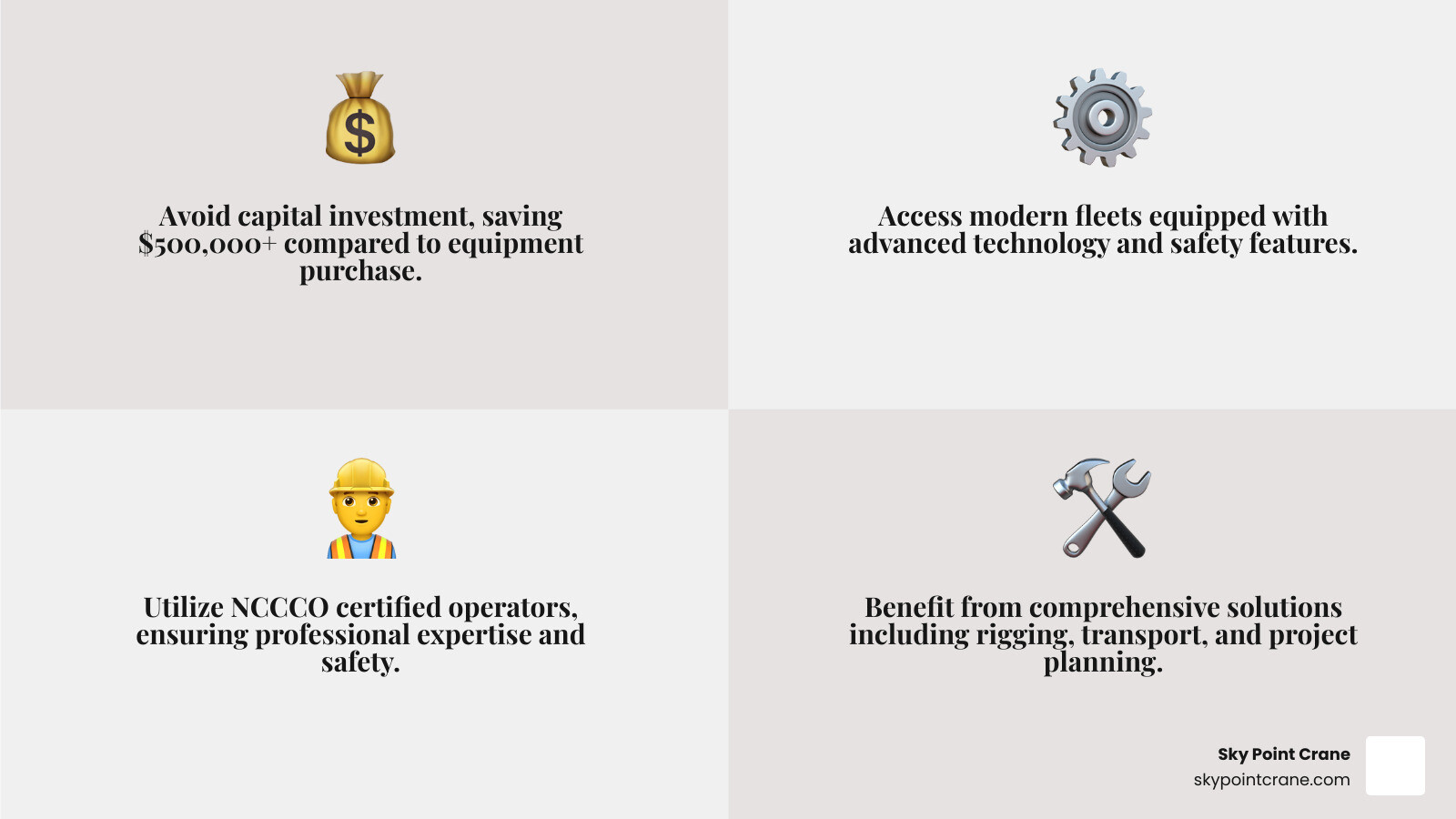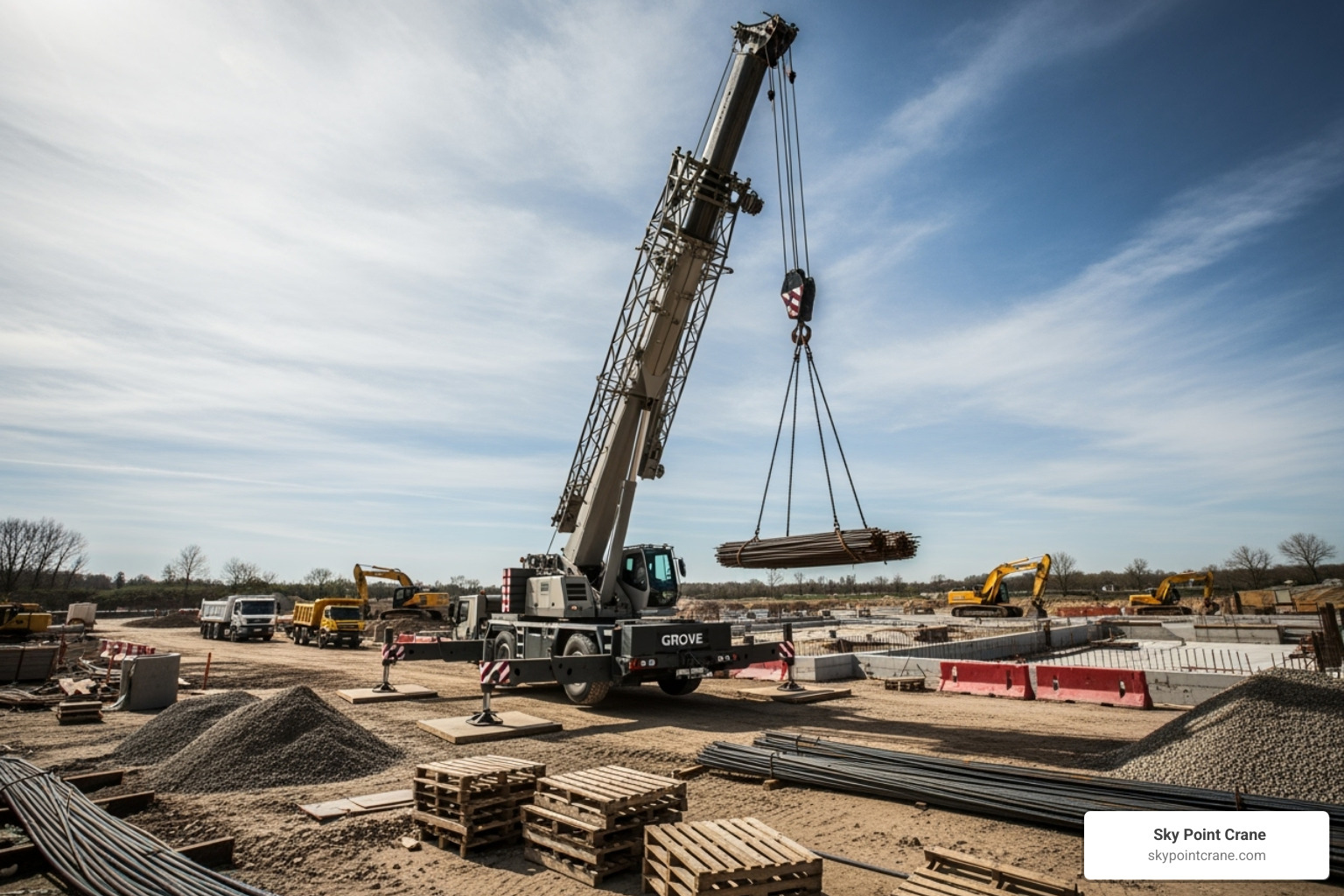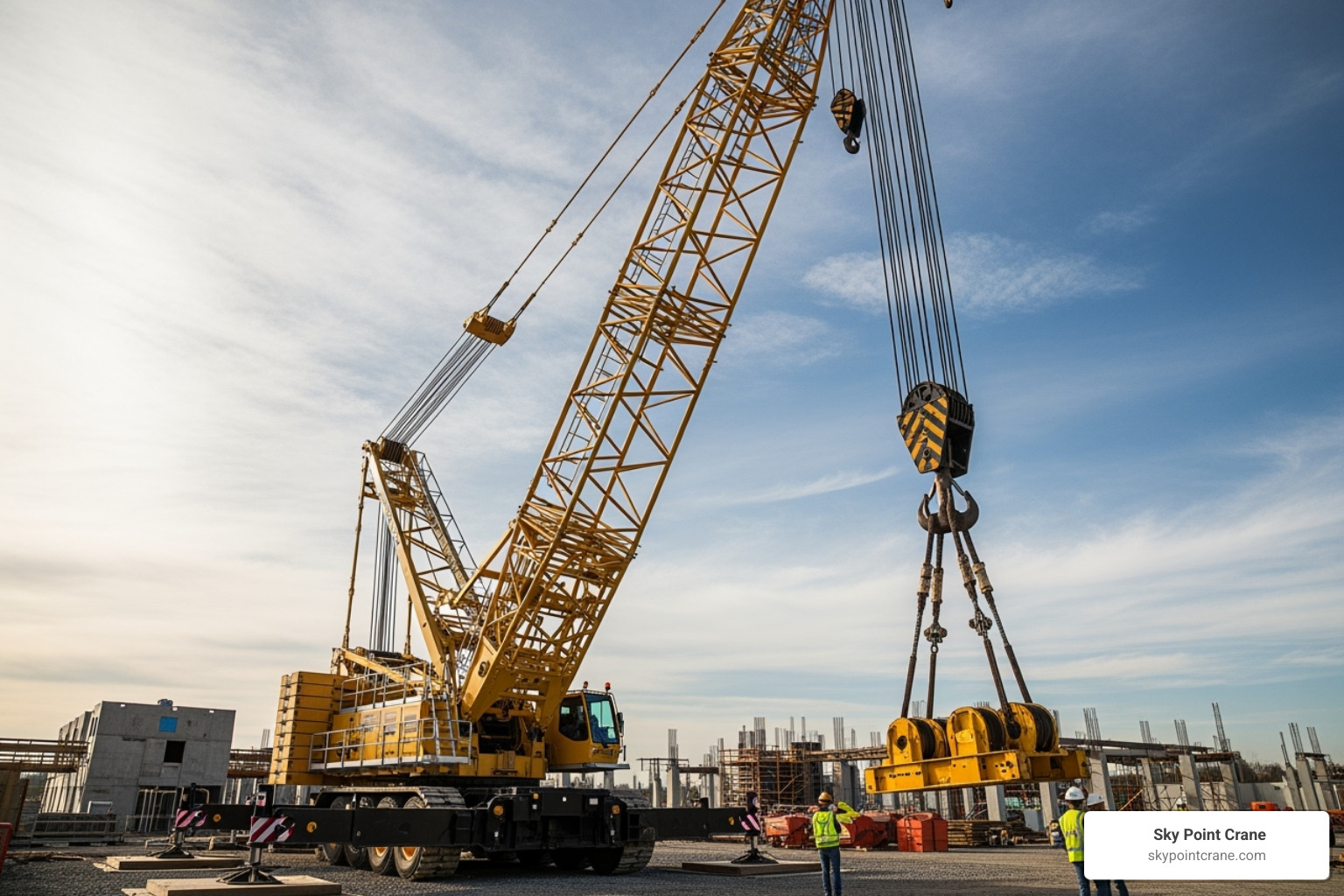Why Heavy-Duty Crane Rental is Essential for Modern Construction Projects
Heavy-duty crane rental provides construction managers with access to specialized lifting equipment without the massive capital investment of purchasing. When your project demands precision lifting of loads exceeding 30 tons, renting gives you flexibility, expertise, and the right equipment for each unique challenge.
Key Benefits of Heavy-Duty Crane Rental:
- No Capital Investment – Avoid $500,000+ equipment purchases
- Access to Latest Technology – Modern fleets with advanced safety features
- NCCCO Certified Operators – Professional expertise included
- 24/7 Emergency Service – Available when you need it most
- Comprehensive Solutions – Includes rigging, transport, and project planning
- Right Equipment Match – Choose from all-terrain, crawler, and boom truck options
Modern heavy-duty crane rental goes beyond just equipment. Leading providers offer 3D lift planning, specialized rigging services, and heavy hauling logistics to ensure your project runs smoothly from start to finish. With rental fleets ranging from 30-ton all-terrain cranes to 500-ton crawlers, you can match your equipment precisely to your project requirements.
I’m Dave Brocious, and with over 30 years of experience in strategy, operations, and customer-driven solutions, I’ve seen how the right heavy-duty crane rental partner can make or break a project timeline. At Sky Point Crane, we focus on solving customer problems through responsive service, meaningful relationships, and comprehensive lifting solutions that put safety first.

Basic heavy-duty crane rental terms:
Understanding the Giants: Common Types of Heavy-Duty Cranes
Picture this: you’re standing on a construction site, looking up at a massive piece of steel that needs to be lifted 200 feet into the air. The question isn’t just “Can we lift it?” but “Which giant should we call in to do the job?”
Heavy-duty crane rental gives you access to these mechanical titans, each designed for specific challenges. Think of it like choosing the right tool from a toolbox – except these tools weigh hundreds of tons and can reach into the sky.
| Feature | All-Terrain Cranes | Crawler Cranes | Boom Trucks (Truck Cranes) |
|---|---|---|---|
| Mobility | Excellent on-road and off-road | Limited on-road, excellent on-site | Excellent on-road |
| Setup Time | Relatively quick | Significant (requires assembly) | Very quick |
| Lifting Capacity | High (40-900 tons typically, some up to 1,600 tons) | Highest (30-2,535 tons typically, some up to 1,600 tons) | Moderate (15-25 tons typically, some up to 45 tons) |
| Ideal Terrain | Paved roads, rough terrain, confined spaces | Soft, uneven ground, large open sites | Paved roads, urban environments |
| Common Uses | Bridges, wind turbines, infrastructure, shorter-duration jobs in tighter quarters | Long-term construction, heavy industrial, large-scale infrastructure, power gen. | HVAC, signs, trusses, material delivery, shorter city jobs, inside refineries |
All-Terrain Cranes
All-terrain cranes are the Swiss Army knives of the crane world, able to cruise down the highway at 55 mph and tackle rough terrain. With multiple axles and sophisticated suspension, they adapt to any ground. Ideal for lifting 40 to 900 tons, they excel at moving between job sites for diverse tasks like setting bridge beams or erecting wind turbines. Their reasonable setup time and versatility make them perfect for projects with changing conditions.
We maintain a modern fleet of all-terrain cranes that are ready for your most challenging projects. More info about our equipment capabilities shows exactly what these machines can handle.
Crawler Cranes
If all-terrain cranes are Swiss Army knives, crawler cranes are the heavy artillery. These track-mounted giants offer maximum stability and the highest lifting capacity, with some able to lift over 2,500 tons. While not road-legal and requiring significant on-site assembly, they are indispensable for long-term projects like skyscrapers or power plants. Their tracks distribute weight effectively, allowing them to operate on soft or uneven ground. For massive steel erection, crawler cranes are the go-to workhorses. Learn more about Crane Rental for Steel Erection and see how these giants handle the biggest jobs.
Boom Trucks (Truck Cranes)
Boom trucks are the reliable, mobile solution for quick jobs. Mounted on a commercial truck chassis, they are highway-legal with fast setup times. With capacities of 15 to 45 tons, they are perfect for urban tasks like HVAC installations, setting signs, or material delivery in tight spaces. Their cost-effectiveness makes them ideal for shorter-duration jobs where you don’t need massive lifting power. Check out our Crane Rental for Tree Removal services to see these versatile machines in action.
Other Specialized Cranes
Beyond the big three, we also have specialized cranes for unique challenges:
Rough Terrain (RT) Cranes are built tough for off-road work. With rugged tires and four-wheel drive, they handle challenging terrain that would stop other cranes. They’re not highway-legal, but for construction sites with difficult access, they’re perfect. Lifting capacities typically range from 15 to 80 tons.
Carry Deck Cranes are the compact solution for tight spaces and indoor projects. These maneuverable machines feature 360-degree boom rotation and a load deck for efficient material transport. With capacities from 2.5 to 18 tons, they’re ideal when you need precision in confined areas.

The beauty of heavy-duty crane rental is having access to all these options without owning them. Whether your project needs the versatility of an all-terrain crane, the raw power of a crawler, or the mobility of a boom truck, we have the right machine ready to work.
The Smart Choice: Key Benefits of Renting vs. Buying
When you’re staring down a massive lifting project, the question inevitably comes up: should we buy or rent? It’s a decision that can make or break your project budget and timeline. While purchasing might seem like the obvious choice for companies with frequent lifting needs, heavy-duty crane rental often proves to be the smarter move for most businesses.
Financial Advantages
A heavy-duty crane can cost anywhere from $500,000 to several million dollars. Heavy-duty crane rental changes this massive capital expense into a predictable operational cost.
Renting avoids a large capital outlay, keeping your cash free for growth, hiring, or other projects. It also helps you avoid depreciation, as owned equipment loses value annually. With rentals, that’s not your concern. Furthermore, renting eliminates maintenance and storage costs. Ownership involves hidden expenses for storage, regular maintenance, repairs, and inspections, all of which are covered by the rental company.
The beauty of rental lies in predictable project expenses. You know your lifting costs upfront, making project bidding and budgeting more accurate, with no surprise repair bills to throw your timeline off track. The Economics of Crane Rentals breaks down these financial benefits in detail.
Operational Flexibility and Access to Expertise
Beyond the dollars and cents, renting gives you something even more valuable – flexibility and expertise that’s impossible to match with ownership.
Renting provides access to a diverse fleet, ensuring you always have the right crane for every job. Instead of making do with what you own, you can choose the perfect machine for each unique challenge. It’s like having a fully stocked toolbox without buying every tool.
Rentals also provide access to the latest technology. Rental companies constantly update their fleets with the newest safety and efficiency features, giving you access to cutting-edge equipment without the cost of upgrading.
Perhaps most importantly, includes certified operators and expert support means you’re not just renting a machine – you’re gaining a team of professionals. Our NCCCO certified operators bring years of experience and specialized training to your project. This removes the headache of hiring, training, and certifying your own operators while ensuring the highest safety standards.
This comprehensive approach to service is what sets professional heavy-duty crane rental apart from simple equipment rental. You’re partnering with experts who understand the complexities of heavy lifting and are committed to your project’s success. Learn more about our reliable crane services and find how the right rental partner can transform your next big lift.
How to Choose the Right Heavy-Duty Crane Rental Partner
Finding the right heavy-duty crane rental partner is like choosing a teammate for the most critical play of the game. You need someone who not only has the right equipment but also shares your commitment to getting the job done safely and on time.
The difference between a good crane rental company and a great one often comes down to the details. It’s not just about having cranes available – it’s about having the right crane, maintained properly, operated by skilled professionals, and backed by comprehensive support services.
Evaluating a Heavy-Duty Crane Rental Company’s Fleet and Safety
When evaluating potential partners, start with their fleet. A diverse fleet shows if a company can handle your project’s specific needs. You don’t want to find out mid-planning that they lack the right crane.
Modern equipment improves safety and efficiency. Well-maintained, updated cranes perform better and have fewer breakdowns. Inquire about fleet age and maintenance schedules to gauge a company’s commitment to your project’s success.
Maintenance records might seem like boring paperwork, but they’re actually your window into how seriously a company takes equipment reliability. Proper maintenance prevents the kind of breakdowns that can derail your timeline and budget.
NCCCO certified operators are non-negotiable. This certification means your operator has met rigorous national standards for crane operation. It’s your assurance that the person running your crane knows what they’re doing and prioritizes safety above all else.
OSHA compliance should be a given, but it’s worth confirming. Look for companies that follow all OSHA safety regulations and conduct regular inspections. A company that takes shortcuts on safety will eventually take shortcuts that affect your project. For detailed information on what to look for, check out our guide on Crane Rental Company Safety Protocols: What to Look For Before Your Next Big Lift and review the Official OSHA Crane Safety Standards.
What Comprehensive Services Should a Heavy-Duty Crane Rental Provider Offer?
The best heavy-duty crane rental companies understand that you’re not just renting a piece of equipment – you’re looking for a complete solution to your lifting challenges.
24/7 availability isn’t just a nice-to-have feature; it’s essential when you’re working on tight deadlines or dealing with unexpected situations. Construction doesn’t always happen during business hours, and neither should crane support. We provide round-the-clock service because we know your project can’t wait.
Project management services can transform a complex lift from a logistical nightmare into a smooth operation. When your rental partner takes responsibility for coordinating all aspects of the lift, you can focus on your core construction activities.
3D Lift Planning represents the cutting edge of crane operation planning. This technology allows us to visualize your lift in detail before we ever arrive on site, identifying potential obstacles and optimizing crane placement for maximum safety and efficiency.
Transportation and heavy hauling logistics are often overlooked until the day your crane needs to arrive. A full-service provider handles all the details of getting your crane to your site and removing it when the job is done, complete with all necessary permits and route planning.
Rigging services complete the package. Many heavy lifts require specialized rigging equipment and expertise that goes beyond basic crane operation. Having access to skilled riggers and the right rigging equipment as part of your rental package eliminates the need to coordinate multiple contractors.
The goal is finding a partner who makes your job easier, not more complicated. When you work with a company that offers comprehensive services, you get single-point accountability and seamless coordination. To learn more about what makes a great crane service provider, read our detailed guide on What to Look For When Hiring a Crane Service Provider.
From Blueprint to Execution: Planning, Safety, and Logistics
Every successful heavy lift starts long before the crane arrives on site. The difference between a smooth operation and a costly disaster often comes down to one thing: planning. Think of it like building a house – you wouldn’t start laying bricks without blueprints, and you shouldn’t attempt a heavy lift without a comprehensive plan.

The Critical Role of Lift Planning and Technology
Modern heavy-duty crane rental operations rely heavily on precise calculations and advanced technology. Gone are the days of guesswork and crossed fingers.
Lifting capacity and reach calculations form the foundation of every safe lift. We need to know exactly what we’re lifting – not just the load itself, but every piece of rigging equipment attached to it. A 10-ton air conditioning unit becomes an 11-ton lift once you add slings, shackles, and spreader bars.
The math gets more complex when you factor in lift height and radius. The higher and farther from the crane’s center you need to reach, the less weight the crane can safely handle. It’s like holding a heavy suitcase – easy when it’s close to your body, much harder when you extend your arms.
Site assessment is where experience really matters. We examine ground conditions to ensure they can support the crane’s massive weight. We identify overhead power lines, underground utilities, and potential access issues. Every detail matters because surprises during a lift can be dangerous and expensive.
This is where 3D Lift Planning software becomes invaluable. This technology creates a virtual model of your entire lift operation, allowing us to spot potential problems before they become real ones. We can visualize the crane’s position, swing radius, and load path in three dimensions. It’s like having X-ray vision for your project.
Our expertise in Heavy Lift Crane Planning Solutions and 3D Lift Planning ensures every aspect of your lift is carefully considered and optimized for safety and efficiency.
Industries Served and Rental Structures
Heavy-duty crane rental serves as the backbone for numerous industries, each with unique challenges and requirements.
Construction projects represent our bread and butter – from setting steel beams for skyscrapers to placing precast concrete sections for bridges. HVAC installations keep our boom trucks busy, especially in urban environments where quick setup and mobility matter most.
The energy sector presents challenging work, including wind turbine installations requiring precise coordination and massive reach, and power plant maintenance involving lifting generators and transformers weighing hundreds of tons. Crane Use in the Construction of Electrical Transmission Lines showcases the specialized expertise these projects demand.
Manufacturing and industrial facilities rely on our services for equipment installation and plant maintenance. Whether it’s positioning a new production line or replacing a massive compressor, these jobs often require cranes that can work in tight spaces with minimal disruption to ongoing operations.
Our rental structures offer flexibility to match your project needs. Hourly rentals work well for quick lifts, while daily, weekly, or monthly arrangements suit longer projects. We offer both bare rental options where you provide the operator, and operated rentals where our NCCCO certified professionals handle the controls.
Pricing typically includes minimum charges and may factor in travel time from our yard to your site. Additional costs can arise from specific boom configurations, required permits, or travel restrictions, but we’ll discuss all these details upfront so there are no surprises.
Integrating Transport and Rigging for a Seamless Project
A successful heavy lift involves much more than just the crane – it’s an orchestrated effort that begins with getting equipment to your site and ends with everything safely in place.
Heavy hauling logistics are complex. Moving large cranes requires specialized trailers, route planning, and permits. We handle all these details, including analyzing bridge weight limits and coordinating with local authorities for oversized load permits. Our Full Service Heavy Lift Transport Solutions ensure your equipment arrives when and where you need it.
Specialized rigging is an art form that combines engineering precision with hands-on experience. Every load presents unique challenges – how do you safely lift an irregularly shaped piece of equipment? What’s the best way to distribute weight across multiple attachment points? Our rigging specialists have the equipment and expertise to handle complex loads safely.
On-site project management ties everything together. For complex projects, having a single point of contact who understands every aspect of the operation makes all the difference. Our project managers coordinate between crane operators, riggers, transport teams, and your personnel to ensure smooth execution.
This integrated approach to Managing Crane Projects from Planning to Execution means you can focus on your core business while we handle the heavy lifting logistics. After all, that’s what we do best.
Frequently Asked Questions about Heavy-Duty Cranes
When you’re considering heavy-duty crane rental for your project, it’s natural to have questions. We’ve been helping customers steer these decisions for years, and we know the concerns that keep project managers up at night. Here are the questions we hear most often, along with straightforward answers that’ll help you move forward with confidence.
How do I determine the right size crane for my project?
Choosing the right crane size isn’t just about picking the biggest one available – it’s about finding the perfect match for your specific needs. Getting this decision right affects both your safety and your budget, so let’s break down what really matters.
Load weight is your starting point. You need to know exactly what you’re lifting, including all the rigging equipment that’ll be attached. That HVAC unit might weigh 8 tons, but add the spreader bar and slings, and you’re looking at closer to 9 tons.
Lift height determines how much boom you’ll need extended. The higher the lift, the more the crane’s capacity decreases – it’s simple physics. A crane that can lift 50 tons at 30 feet might only handle 25 tons at 80 feet.
Lift radius is the horizontal distance from the crane’s center to your load. This is where many people get surprised – as that radius increases, your lifting capacity drops significantly. What seems like a small difference in positioning can mean the difference between a 40-ton crane and needing a 60-ton machine.
Site conditions can make or break your crane choice. Is the ground soft? You might need a crawler crane with tracks instead of an all-terrain on tires. Working in downtown with tight streets? A boom truck could be your best bet. Overhead power lines or buildings? That changes everything about your approach.
While understanding these factors is helpful, consulting with experts is crucial. Many projects encounter issues from guesswork. Our team uses tools like 3D lift planning to model your situation and recommend the right equipment. Learn more about our approach at Heavy Lift Crane Planning Solutions.
What certifications should a crane operator have?
When it comes to crane operations, there’s no room for “learning on the job.” The operator in that cab holds your project’s success – and everyone’s safety – in their hands. That’s why we’re absolutely strict about certifications.
NCCCO certification is the industry’s gold standard. It involves rigorous written and practical exams, proving an operator’s competency in technical skills and safety protocols. When you see NCCCO certification, you know that operator has demonstrated real competency.
But certification is just the beginning. OEM training is vital to ensure operators know the specific crane model they’re using. General certification isn’t enough, as each machine has unique controls and features.
For complex job sites, site-specific training becomes essential. Working around chemical plants, near airports, or on bridges requires understanding special procedures and emergency protocols. The best operators accept this additional training because they know it keeps everyone safer.
Verifying credentials should be automatic, not optional. Any reputable heavy-duty crane rental company will provide proof of certification without you having to ask twice. We maintain detailed records of our operators’ qualifications and training history because transparency builds trust. You can read more about our safety standards at Crane Rental Company Safety Protocols: What to Look For Before Your Next Big Lift.
What is included in a typical rental agreement?
Nobody likes surprises when it comes to project costs, so let’s talk about what you should expect in a heavy-duty crane rental agreement – and what might cost extra.
The crane equipment itself is obviously included, but make sure the agreement specifies the exact model and configuration you’re getting. If you need a specific boom length or jib attachment, get that in writing.
When you choose operated rental (which we recommend for most projects), you’ll get a certified operator included in the price. For larger cranes, we might also include an oiler to assist with operations. These aren’t just equipment operators – they’re skilled professionals who become part of your project team.
Standard rigging equipment like slings, shackles, and basic spreader bars typically comes with the rental. However, if your lift requires specialized rigging – maybe custom spreader beams or unusual configurations – that’s usually an additional service.
Insurance coverage should be clearly outlined in your agreement. We carry comprehensive coverage, but you’ll want to understand exactly what’s covered and what responsibilities remain with you.
Now, let’s talk about common exclusions that sometimes catch people off guard. Permits for oversized loads or street closures are typically your responsibility, though we’re happy to help you understand what’s needed. Fuel consumption is usually charged separately based on actual usage. Site preparation costs – like improving access roads or preparing crane pads – aren’t included in the crane rental.
Overtime and weekend work comes at premium rates. Most agreements assume standard weekday hours, so if you need work done evenings, weekends, or holidays, expect higher rates.
The key is reading your agreement carefully and asking questions upfront. We believe in complete transparency because surprises don’t help anyone’s project succeed. For more detailed guidance on what to look for, check out our comprehensive guide at What to Look For When Hiring a Crane Service Provider.
Conclusion: Partnering for a Successful Lift
Throughout this guide, we’ve explored heavy-duty crane rental and why it often outperforms buying. Renting removes major capital costs while giving you modern equipment, certified operators, and predictable pricing.
The key is selecting a partner with a well-maintained fleet, rigorous safety standards, and value-added services like 3D lift planning, rigging, and project management.
Sky Point Crane delivers that package. Serving Western and Central Pennsylvania, Ohio, West Virginia, and Maryland, our NCCCO certified team is ready 24/7 to keep your project on schedule and on budget.
Ready to get started? Explore our full range of crane services to ensure your next project is a success and let’s lift your ambitions to new heights—safely and efficiently.


